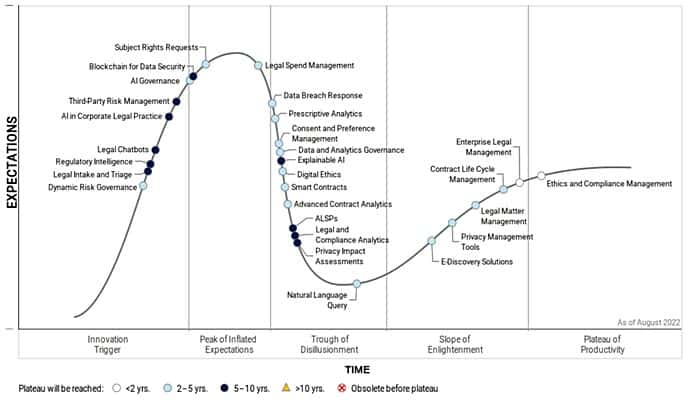Gartner says many legal departments are struggling to implement emerging technologies while also failing to adopt some of the most impactful legal and compliance technologies.
“The technology landscape in legal and compliance has been dynamic in recent years with many new offerings and vendors entering the space,” said Zack Hutto, director of advisory in the Gartner Legal, Risk & Compliance practice.
“Many legal departments are becoming disillusioned with more nascent technologies. Teams are also failing to successfully adopt maturing technologies with the most established benefits,” he added.
The Gartner Hype Cycle for Legal and Compliance Technologies 2022 helps legal departments plan out the most significant technology opportunities for their departments.
The Gartner Hype Cycle provides a view of how a technology or application will evolve over time, providing a source of insight to manage its deployment within the context of a specific business goal. It allows clients to get educated about the promise of an emerging technology within the context of their industry and an individual appetite for risk.
The maturation of foundational legal technologies such as contract lifecycle management and legal matter management are on the Slope of Enlightenment (see Figure 1). However, these well-established innovations have a market penetration of under 50%.

Figure 1: Hype Cycle for Legal and Compliance Technologies, 2022
Source: Gartner (October 2022)
“The fact that at least half of legal departments haven’t put in place foundational systems of record in these areas means that more sophisticated innovations will be much harder to exploit successfully,” said Hutto. “Departments are foregoing significant efficiency gains by the day while such foundational systems are not in place.”
Pre-enlightenment technologies
A combination of poor digital dexterity in legal teams and significant hype in the marketplace has left many departments struggling to implement both foundational platforms and more sophisticated functionalities, many of which can be found in a crowded trough of disillusionment on the 2022 Hype Cycle.
“The technologies in the trough of disillusionment demonstrate a broad picture of legal departments – spurred on by big claims from vendors – trying to run before they can walk, or flat out investing in the wrong solution for their needs,” said Hutto.
He opined that given their relatively low-risk tolerance with technology; leaders should focus on the best-understood, most reliable innovations first – the foundational systems on the Slope of Enlightenment.

“Leaders must ask themselves, ‘What are we missing here? Is that a deliberate decision?’ Then, for more emerging innovations, ‘What could we be using? Are we ready for those investments?’ This will set them up to successfully adopt more advanced innovations.”
Zack Hutto
At the Innovation Trigger stage, some of the technologies that are set to mature in 5-10 years have even greater transformational potential than those currently in the Trough of Disillusionment. Firstly, increasing regulatory oversight, geopolitical tensions and the COVID-19 pandemic have led to unprecedented regulatory change.
“Leading teams are reassessing their portfolio of regulatory intelligence resources, with many seeking alternative solutions to costly law firms and in-house resources,” said Hutto. “But the market today is fragmented and replete with M&A activity, and it’s not always transparent what risk terrains are supported by vendors, which makes buying decisions very complex.”
Secondly, many legal teams have well-established methods for managing external work (i.e., tasks handled by law firms or ALSPs); however, those methods rarely extend to internal work (i.e., work handled by in-house lawyers and nonlawyer professionals), with most legal departments lacking systematic intake and triage.
“Current legal workloads are unmanageable, and lawyers are exhausted,” said Hutto. He added that intake and triage help address these problems by allowing legal teams to control what work they do, and how they do it.
“Therefore, it has the potential to radically improve departmental productivity. The sorts of data amassed from an intake and triage method can also unlock transformational opportunities to manage demand proactively and invest in automation,” concluded Hutton.





